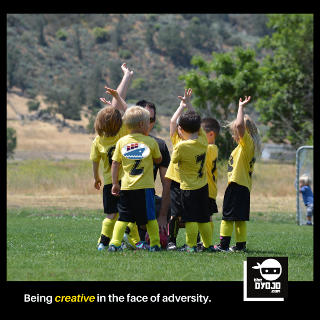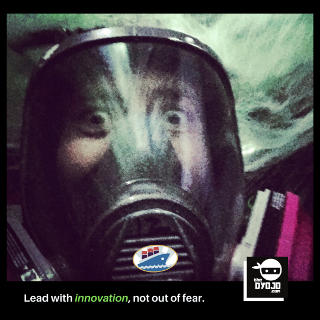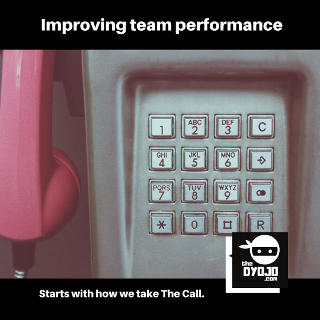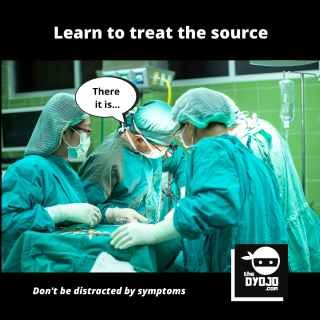COVID-19 is exposing holes in leadership-think and business systems, it's time to adapt or die. When I coached soccer for young kids, every season a unanimous point of contention was running. Ask any coach, if the kids are acting up, “Just make them run.” While conditioning is an essential component of the sport, it’s trite how often running is utilized as a disciplinary tool as well. On the other side of the ball, what do players complain about, “Why do we have to run so much?” I knew it was my role as a coach to teach these kids the fundamentals of soccer and to help them be competitive in our matches, but I understood quickly that if we could make the process enjoyable we would get much further in reaching our goals. Don’t get me wrong, I used to love it when kids whined about conditioning, I would ask, “If you don’t like to run, why did you pick soccer.” Some of them would reply, “I didn’t, my mom is making me play.” Touché. If we put ourselves in the young players mindset, they just spent the day at school sitting in a classroom getting lectured about things many of them are not interested in. They see an open field and their friends and they want to play. As coaches, we decided that we didn’t want to make running a constant punishment, we wanted the kids to enjoy the sport. Yet, we probably ran more than most teams in our league. How you phrase the conversation with affect you ability to implement changesAs we navigate the working world with COVID-19, I can’t help but see some parallels with the above scenario and the discussions around companies attempting to navigate their staff working remotely. I hear several employers contemplating aloud whether employees can be as productive working from home as they are working from the office. We will break some of this down, but one piece of the puzzle I would like to present to those in a position of leadership is how you phrase the conversation. In my coaching days, I discovered a very simple drill. The kids would gather into two lines with one coach in the middle. Coaches would throw a soccer ball as far as they could and the players would run to retrieve it and then scrimmage one-on-one the whole way back. The players literally sprinted to get the ball, they worked on footwork with opposition on the way back and everyone was gasping for air by the time our drill was done. Cardio, skills and scenarios in one simple drill. No one complained about having to run because the running was wrapped into an exercise that we were all doing together. We accomplished quite a bit by being creative. Working remotely is something every company should be experimenting with for the purpose of attracting young talent, providing options to retain existing talent and developing resiliency. Even prior to the novel coronavirus (SARS-CoV-2) outbreak, in the Pacific Northwest there have been many talks about a Cascadia earthquake event as well as other emergency scenarios which should have sparked remote work conversations. The world is changed and your only path to success is forwardThis pandemic is changing our lives and our economy. Life will not be the same once we flatten the curve and develop solutions to COVID-19. So many companies are making bad press for themselves with the public and with their employees through their haphazard actions. As a person in a position of leadership, you will never please everyone, but you must lead. This pandemic is exposing holes in systems worldwide that were not being tightened up because we were all prospering. Now that things are rapidly changing it is time to make adaptations that should have happened long ago. Communication is key. I am thankful that in Tacoma, Washington, the Chamber of Commerce and the Economic Business Development, among others, have been holding tri-weekly updates on facts and resources for local businesses. No one has all of the answers and we are putting this puzzle together one piece at a time. Setting up company updates about:
If you aren’t listening to your employees, you may be missing out on some key opportunities for collaboration and ideas that could save your business. Your concerns about remote work are with your systems not your people There are companies that already have significant portions of their workforce working remotely. I know of one technologically savvy company in the real estate space that provides parameters as well as freedom for their agents. This company has “peak hour” requirements where employees are required to keep a certain amount of their day/week open in those time frames when clients have the most need for service. A process like this demonstrates that the company has a firm grasp on what their clients needs and habits are as well as a means to align their workforce with that business stream. Even before coronavirus, as a person in a position of leadership, you should be asking whether your current process aligns your workforce with your client needs. A common objection to working from home is that employees won’t be as productive. Somehow, people in a position of leadership believe that employees sitting at a desk where they can be observed are somehow more productive. This is like sleeping with the light on when you are scared. It’s ridiculous. If there really is a threat, the presence of a 60 watt bulb will not stop a monster, nor does the “watchful eye” of a “trained manager” increase worker productivity. Setting your team up for success by creating a measurable processI am intentionally not including sources to support my position, if you feel strongly about working from home then you will find research that will support your position (confirmation bias) one way or the other. My contention would be that sitting at a desk is a piss poor metric for productivity. If you are that leader, my questions would be:
In my experience, the same people who judge productivity by butts in seats are the same companies that have no real systems for performance evaluation or improvement. Now is the time to get real about what a productive employee looks like in your organization. When I was coaching, it was the same thing there, coaches would brag about how often their kids ran because they were misbehaving. Many of them had terrible teams full of players who didn’t enjoy the sport and had no passion for learning. Too often as coaches or people in a position of leadership we blame the employee or the player. Soccer is supposed to be fun. It’s a hard game but it’s a blast if you can learn to improve a few key skills. Business as well is fun, it is a blast to land a contract, build relationships and see your team thrive. Now, more than ever, is a time for people in a position of leadership to step upLeaders need to lead. Crisis has a way of exposing the flaws in our systems. If you are resting on what you accomplished in the past or how you did things even a week ago, you aren’t leading and your company will die. Embrace innovation but understand it doesn’t have to be something crazy, going back to our simple “running” drill - it had a purpose, touched on key performance points and we all had fun doing it. Business can be this same way. With a little bit of thought, some clarity on expectations for this new world and a willingness to adapt as you all learn together, businesses can make some win-win scenarios that will keep talent as well as help them chart a path forward. What are you doing to create clarity, consistency and accountability in these key areas?
0 Comments
Improving your property restoration business through consistent optimization efforts.“When setting expectations, no matter what has been said or written, if substandard performance is accepted and no one is held accountable—if there are no  This article was featured as part of our monthly column The Intentional Restorer (volume 3) with Restoration and Remediation Magazine (R&R). Whether your career path started in property restoration or in some other industry, you know what it is like to work you way up from an entry level position to where you are now. You remember what it is like to have something go wrong and to be blamed for that result. The typical approach in hierarchical management systems is for the blame to “roll downhill”, right? But, as a person in a position of leadership (at whatever level you find yourself), you have committed yourself to reaching for higher purpose for yourself as well as your team. It’s so much easier to maintain the status quo. Yet, with the rate of change and the demands in the market, you know that doing things the way we’ve always done them is a rapid path to obsolescence. Change is painful but death is permanent. Doing the hard things of turning something around or improving your system requires commitment to work through obstacle after obstacle and to consistently progress through opposition. The battle for improvement is never over, you rise and grind only to wake up and do it again. Elevate performance by clarifying expectationsDedicated leaders, like yourself, understand that assigning blame is not a strategy for success when working to improve your internal processes. You understand that as a leader, “The buck stops here,” with regards to accountability for making progress in the process. Developing your team to embrace a growth mindset, that will lead to sustained competitive production, requires intentional leadership. Long term success follows a sequence of clarity, consistency and accountability.
As an example for how this process plays out, let’s take a look into a typical day for a property restoration team. We will identify some of those core issues that hold teams back from reaching their goals, discuss potential solutions and then apply those concepts to your business. Quiet on set, begin scene: Team Leader, we will call him Charles, asks his business mentor, “How do we get our technicians to fill out their paperwork consistently, thoroughly and on time?” “How often do you provide your technicians with clear and consistent paperwork before they arrive on a job site?” Business Mentor, we will call her Shirley, responds to the question with a question. “What are you talking about? These are emergencies we are responding to.” Charles clearly thinks Shirley has lost her marbles. “Whether you are responding to an emergency or facilitating a repair, isn’t your client intake process the same?” Shirley feels the indignation but does not respond to it. “What does that have to do with my technicians not doing their job?” Charles is ready to throw Shirley out of the building. “The best way to build accountability in vision and values is to demonstrate them from top to bottom.” Shirley calmly presses forward. “Oh, so it’s my fault now? I’m the reason my technicians don’t do their paperwork consistently and on time?” Charles stretches his hand towards the shoulder of Shirley. “Before you throw me out of the building, let’s look at a few things...“ Building team accountability starts with leadership executing their responsibilitiesHow consistent and thorough are your project assignments? Does your organization provide clear enough details to your front line employees to set them up for success when responding to a work assignment? Too often we use the excuse that we respond to emergencies to allow us to generate unclear work scopes. Where does the process of clear scope and expectations begin? You know the answer--it begins with whomever is taking the phone call. Resource: We dealt with the 5 layers of consistent customer communication in an article with Restoration & Remediation Magazine How often do you receive unclear details from a client?
Does unclear data cost your business time, resources and profitability? Yes. The process of clear communication through complete, thorough and timely paperwork starts with your investment in the process of receiving project information. You cannot control when a lead comes in but you can control how thoroughly you gather information. This is important so that no one on your team is wasting time duplicating efforts to get the information that should have been received when the call came in. You may not know all the details for an emergency but if you have enough data we can prepare your team to respond with the appropriate people power, equipment and materials. You know that there is a big difference between responding to a sink overflow in a laundry room on the main floor with no crawl space and a busted sewer line in the crawl space of a 5,000 square foot home. The technicians who are trained to respond, the equipment and resources that will be needed as well as the ability to estimate how that team being offline for the project will impact your ability to respond to other losses are all important. Improving profitability starts with clarifying your internal processConsistency in your paperwork starts with details gathered at the time a call for a new project is received (intake).
Consistency in your process will fuel improvements in your productionThe details will make or break a well documented loss that will enable you to get paid for your work on an insurance claim. The details of your process and the workflow consistency will make or break your ability to elevate your teams performance. When you master the most basic functions of your organization it builds momentum for tackling more complex issues within your process. When you detect negative symptoms in your business, such as a lack of thoroughness in the project documentation from your team members in the field, it should cause you to seek the root sources. It sounds simple and yet it when these things are not practiced there are negative ripples throughout the organization. When you commit to taking calls with clarity and consistency you demonstrate to your team that you value this process and that everyone is being held to the same standard. You can begin to eliminate chaos in your organization and build positive momentum by intentionally developing your process. Too often teams under utilize their receptionist and allow their salespeople to get away with maneuvering around the rules. When you build clarity and consistency you establish purpose for each person in your organization. When you stand up for these principles, as change will always be tested, you prove your commitment to the cause. Steps for improving employee performanceIf you want to motivate your property restoration employees to higher quality performance and expect consistency from your technicians:
Check out our video on this topic - Garbage In, Garbage Out (Part 1) - The Call. Leadership development must include the skill to address dysfunction. Treating the sources of dysfunction Treating the sources of dysfunction When someone near you sneezes, do you brace yourself and think, “Great, now I’m going to get sick?” You experience the external symptom and know it reveals that this person has either had a reaction to something or that they are ill. The sneeze could carry particles of some disease that will spread to yourself and others. You may say, “Bless you,” or offer your favorite remedies for the common cold. You know that when someone sneezes (symptom) there is an underlying source. On the other hand, in business, you experience dysfunction all the time and yet get sidetracked by thinking solely about the symptoms. Symptoms are what attract our attention yet sources are where solutions must be applied. As a person in a position of leadership, it is important to intentionally develop your ability to decipher the nuances between symptoms and sources if you want to be effective with leading your team. Understanding the cost of dysfunction as a leader.What is the difference between a symptom and the source when addressing dysfunction? The online Oxford Dictionary definition of a symptom (noun) is, “A physical or mental feature which is regarded as indicating a condition of disease, particularly such a feature that is apparent to the patient.” When used in a sentence, "Dental problems may be a symptom of other illness." As noted above, you as a patient begin to experience tooth pain. The pain is a symptom of some source. It could be a cavity, a sensitive tooth or something much greater such as decay or infection. Ibuprofen may temporarily treat the symptom of pain but it will not address the source. After a few days of increasing discomfort, you decide to go to the dentist to determine the issue and discuss solutions. Interestingly, the online Oxford Dictionary uses another example which is apropo both to our culture as well as the business environment, “A sign of the existence of something, especially of an undesirable situation.” The importance of developing leadership skills that will address organizational dysfunction.The second sentence utilization from Oxford states, "The government was plagued by leaks—a symptom of divisions and poor morale." In the example, leaks (symptom) in the government were caused by divisions and poor morale (source). I would add that division and poor morale are symptoms of lack of trust and unwillingness to set aside ego for the greater good. When human interactions are involved, the source versus symptom discussion has layers of complexity.
As a person in a position of leadership, you can either peel back the layers of symptoms to address sources or the layers of symptoms can build until they overwhelm your resources and suck the life from your organization. Explore beneath the surface to determine what sources in your team are causing these dysfunctional symptoms. Addressing one layer of symptoms and sources will likely lead to opening another layer. Three key areas of focus for leaders who want to reduce dysfunction in their teams:
Approach leadership like Batman, expand your tool belt by learning from other industries.Batman is unique among the super heroes because his intelligence and innovation are key to his ability to overcome obstacles. The resources available to Batman from his Bat-belt are iconic. As a person in a position of leadership, you must exercise your growth mindset and add resources to your managerial tool belt. We discuss how positive behavior intervention and support (PBIS) professionals approach their work with children and how we can apply that to our work in managing people in business. The PBIS system has been set up with three tiers of prevention with plans of support associated with the needs of the student at each tier:
In behavior, which has so many applications to the modern workplace, how do we define the will, the chill and the skill?
Additional Resources:
|
AuthorThoughts on personal and professional development. Jon Isaacson, The Intentional Restorer, is a contractor, author, and host of The DYOJO Podcast. The goal of The DYOJO is to help growth-minded restoration professionals shorten their DANG learning curve for personal and professional development. You can watch The DYOJO Podcast on YouTube on Thursdays or listen on your favorite podcast platform.
Archives
March 2023
Categories
All
<script type="text/javascript" src="//downloads.mailchimp.com/js/signup-forms/popup/unique-methods/embed.js" data-dojo-config="usePlainJson: true, isDebug: false"></script><script type="text/javascript">window.dojoRequire(["mojo/signup-forms/Loader"], function(L) { L.start({"baseUrl":"mc.us5.list-manage.com","uuid":"b9016446bd3c6a9f0bd835d4e","lid":"83282ffb9e","uniqueMethods":true}) })</script>
|
Jon Isaacson |
Connect. Collaborate. Conquer.
© COPYRIGHT 2015. ALL RIGHTS RESERVED.
|






 RSS Feed
RSS Feed